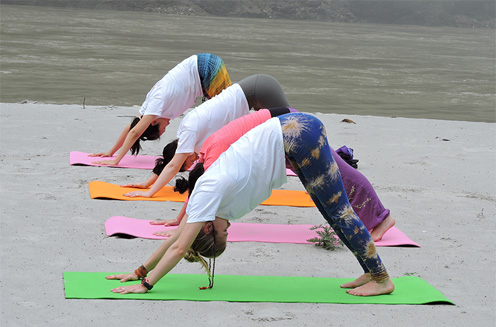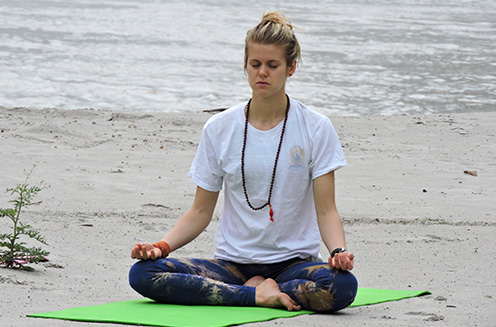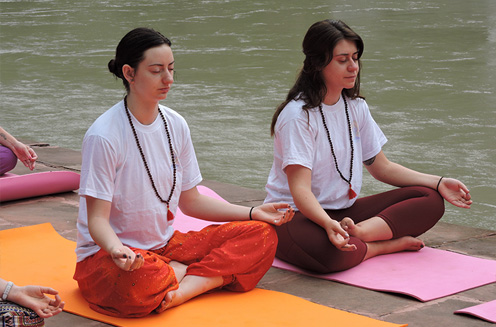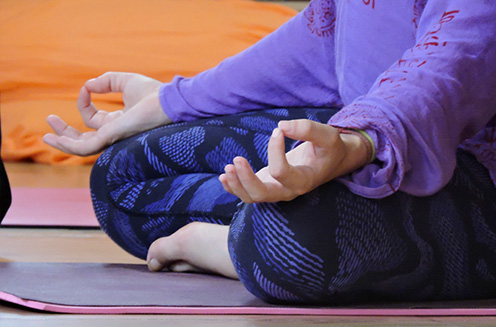Ashtanga Yoga of Maharshi Patanjali is a classical work on Yoga philosophy. The Yoga sutras of the sage provide the comprehensive understanding on the principles and practices of the subject with its scientific background. The discussion on human psychology and its interactions on our body are meticulously explained along with the solutions to be applied for the experience of the life filled with happiness, health and joy in abundance.
The concept of holistic health and wellbeing is achieved through Ashtanga Yoga using its science, technique and philosophy. This structured
Curriculum of Classical Yoga in India has significantly contributed the guidelines for the health and lifestyle.
Sadhana Pada or the study of eight limbs is an important tool for practitioner or Yoga teacher to climb the ladder of the highest step in Yogic path. This section of the study will enhance the ability of the Yoga practitioner in all the dimensions of his personality such as physical, mental, emotional and moral levels in order to culminate in the spiritual journey.
Why to practice eight limbs of Yoga?
Yoga Sutras of
Sadhana Pada explains the two distinct advantages of the practice of 8 limbs as,

The practice of limbs of Yoga helps in the reduction of the impurities and develops the wisdom which is called as discriminative knowledge, capable to bring the awareness of the reality.
What are these eights limbs of Yoga?
Patanjala Yoga Sutra II.29 describes the list of eight limbs as follows

Ashta means eight and Anga means limbs, these are
1. Yama
2. Niyama
3. Asana
4. Pranayama
5. Pratyhahara
6. Dharana
7. Dhayna
8. Samadhi
The above list of practices has certain sequential relationship for the successful practice of Yoga to reap the best possible benefits for the promotion of physical and mental health.
Yama - Code of Conduct
Yama is the practice of Social code of conduct. These values are helpful to maintain the harmony in the society with an individual. They harness the principles of live and let live for the sustainable eco friendly environment in the society using the concepts of sharing and caring. The collective practice of these principles in Yoga regularizes the behavior and personality free from moral impurities. There are five such disciplines, they are -
a. Ahimsa - Non Violence
b. Satya - Truth fullness
c. Asteya- Non Stealing
d. Brahmacahrya - Continence
e. Aparigraha - Non possessiveness
Niyama - Personal Observances
Niyama is the second lesson which is of personal observances. These practices are important to enhance the quality of our willpower, intellect and emotions. This yogic discipline is foundation for the removal of emotional impurities which are stemming from mental toxins such as the feelings of hatred and jealousy.
Yama and Niyama together form the structural basis for the ethical preparation which is an essence of every
Yoga Teacher Training Course. They contribute for the mental peace through the purification of our senses, mind and body. The five personal observances are,
a. Saucha -Cleanliness
b. Santosha - Contentment
c. Tapas -Austerity
d. Swadhyaya -Self study
e. Ishwar pranidhana - Devotion
Asana-body Posture - A Practice for the disciplining the body
Asana is stable and comfortable body posture. The
Practice of Asana brings the steadiness, feeling of lightness and well being. The regular practice of yoga postures develops the best possible physical and mental health. It overcomes the dualities of the mind and body. It is a remedy for the removal of the obstacles such as physical illness. Removal of physical impurities takes place through the poses. They contribute for the homeostasis which is a state of balance in the psycho-physiological, neuro muscular as well as endocrinal mechanisms. There are various therapeutical benefits of Asana for the different systems of our body. It is an important preparation for the practices of pranayama and meditation too. Classical texts on Hatha yoga training syllabus explain the various types of Asana like cultural, meditative and Relaxative poses.
Pranayama - Regulation of the Vital force
Upon the successful practice of Asana, The
Pranayama Practice is undertaken. This practice is useful in the regulation of the vital force. The breath and mind have strong relationships; the stability of the mind is the result of the stability of the breath. It is a process of the purification of the nadis- the subtle energy channels in our systems. The energetic anatomy and physiology of the human body is influenced through these techniques to the greater extent. The blockage in the energy channels dissipates the pranic energy leading to imbalances which result in mental sickness and physical sufferings in the form of abnormal conditions. Different types of Pranayama practices bring the calmness to the mind, develops the qualification for the mental concentration.
Prathyahara - Regulation of the senses.
Prathyahara is the practice of disciplining the senses; this technique establishes the perfection in the mastery for the sense control .Serenity of the mind is possible when our sense organs are under control. Techniques like Yoga Nidra, Inner silence are very good for the training of the senses. The practice helps to eliminate the source of the disturbance by disassociating the sensory inputs to the sense organs from their corresponding objects.
Dharana - Concentration
The practice of concentration is fixing the mind on the object of meditation. This practice reduces the fluctuations of the mental modifications. It is the result of the first five limbs of practices which are called as bahiranga Yoga. The concentration leads the attainment of meditation.
Dhayna - Meditation
The
Practice of Meditation is an unbroken flow of the awareness on the chosen object of contemplation. The physiology of the meditation impacts the entire aspects of our personality from the gross to the subtle experience. This technique harmonizes the physical, mental and emotional experiences to enjoy the state of holistic health and feeling of wellbeing.
Samadhi - The absolute absorption with supreme
This is the highest state of Yoga Sadhana. It is an experience of the bliss in the core of our being. The progressive approach on concentration and meditation gets culminated in this supreme state of Yoga








